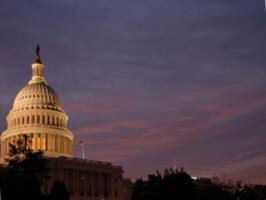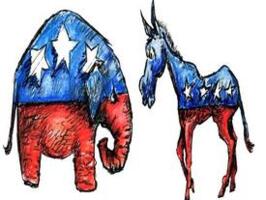America Is Two Countries, Not on Speaking Terms
A Commentary By Michael Barone
You know who won the election (or whether we face another Florida 2000), and as I write I don't.
But whether Barack Obama is re-elected to a second term or Mitt Romney is elected the 45th president, the contours of their support during this fiercely fought campaign show that we live in Two Americas.
The culturally cohesive America of the 1950s that some of us remember, usually glossing over racial segregation and the civil rights movement, is no longer with us and hasn't been for some time.
That was an America of universal media, in which everyone watched one of three similar TV channels and newscasts every night. Radio, 1930s and 1940s movies, and 1950s and early 1960s television painted a reasonably true picture of what was typically American.
That's not the America we live in now. Niche media has replaced universal media.
One America listens to Rush Limbaugh; the other to NPR. Each America has its favorite cable news channel. As for entertainment, Americans have 100-plus cable channels to choose from, and the Internet provides many more options.
Bill Bishop highlighted the political consequences of this in his 2008 book, "The Big Sort." He noted that in 1976 only 27 percent of voters lived in counties carried by one presidential candidate by 20 percent or more. In 2004, nearly twice as many, 48 percent, lived in these landslide counties. That percentage may be even higher this year.
We're more affluent than we were in the 1950s (if you don't think so, try doing without your air conditioning, microwaves, smartphones and Internet connections). And we have used this affluence to seal ourselves off in the America of our choosing while trying to ignore the other America.
We tend to choose the America that is culturally congenial. Most people in the San Francisco Bay area wouldn't consider living in the Dallas-Fort Worth Metroplex, even for much better money. Most Metroplexers would never relocate to the Bay Area.
There are plenty of smart and creative and successful people in both Americas. But they don't like to mix with each other these days.
They especially don't like to talk about politics and the cultural issues that, despite the prominence of economic concerns today, have largely determined our political allegiances over the last two decades.
One America tends to be traditionally religious, personally charitable, appreciative of entrepreneurs and suspicious of government. The other tends to be secular or only mildly religious, less charitable on average, skeptical of business and supportive of government as an instrument to advance liberal causes.
The more conservative America tends to be relatively cohesive. Evangelical Protestants and white Catholics make common cause; the 17th century religious wars are over. Southern or Northern accents don't much matter.
That's typical of the Republican Party, which has always had core support from people seen as typical Americans but who are not by themselves a majority in our always diverse country.
The more liberal America tends to be diverse. Like Obama's 2008 coalition, it includes many at the top and at the bottom of the economic ladder.
That's typical of the Democratic Party, a coalition of disparate groups -- immigrant Catholics and white Southerners long ago, blacks and gentry liberals today.
Ronald Reagan, speaking the language of the old, universal popular culture, could appeal to both Americas. His successors, not so much. Barack Obama, after an auspicious start, has failed to do so.
As a result, there are going to be many Americans profoundly unhappy with the result of this election, whichever way it goes. Those on the losing side will be especially angry with those whose candidate won.
Americans have faced this before. This has been a culturally diverse land from its colonial beginnings. The mid-20th century cultural cohesiveness was the exception, not the rule.
We used to get along by leaving each other alone. The Founders established a limited government, neutral on religion, allowing states, localities and voluntary associations to do much of society's work. Even that didn't always work: We had a Civil War.
An enlarged federal government didn't divide mid-20th century Americans, except on civil rights issues. Otherwise, there was general agreement about the values government should foster.
Now the Two Americas disagree, sharply. Government decisions enthuse one and enrage the other. The election may be over, but the Two Americas are still not on speaking terms.
Michael Barone, senior political analyst for The Washington Examiner, is a resident fellow at the American Enterprise Institute, a Fox News Channel contributor and a co-author of The Almanac of American Politics.
COPYRIGHT 2012 THE WASHINGTON EXAMINER
DISTRIBUTED BY CREATORS.COM
See Other Political Commentaries.
See Other Commentaries by Michael Barone.
Views expressed in this column are those of the author, not those of Rasmussen Reports. Comments about this content should be directed to the author or syndicate.
Rasmussen Reports is a media company specializing in the collection, publication and distribution of public opinion information.
We conduct public opinion polls on a variety of topics to inform our audience on events in the news and other topics of interest. To ensure editorial control and independence, we pay for the polls ourselves and generate revenue through the sale of subscriptions, sponsorships, and advertising. Nightly polling on politics, business and lifestyle topics provides the content to update the Rasmussen Reports web site many times each day. If it's in the news, it's in our polls. Additionally, the data drives a daily update newsletter and various media outlets across the country.
Some information, including the Rasmussen Reports daily Presidential Tracking Poll and commentaries are available for free to the general public. Subscriptions are available for $4.95 a month or 34.95 a year that provide subscribers with exclusive access to more than 20 stories per week on upcoming elections, consumer confidence, and issues that affect us all. For those who are really into the numbers, Platinum Members can review demographic crosstabs and a full history of our data.
To learn more about our methodology, click here.


